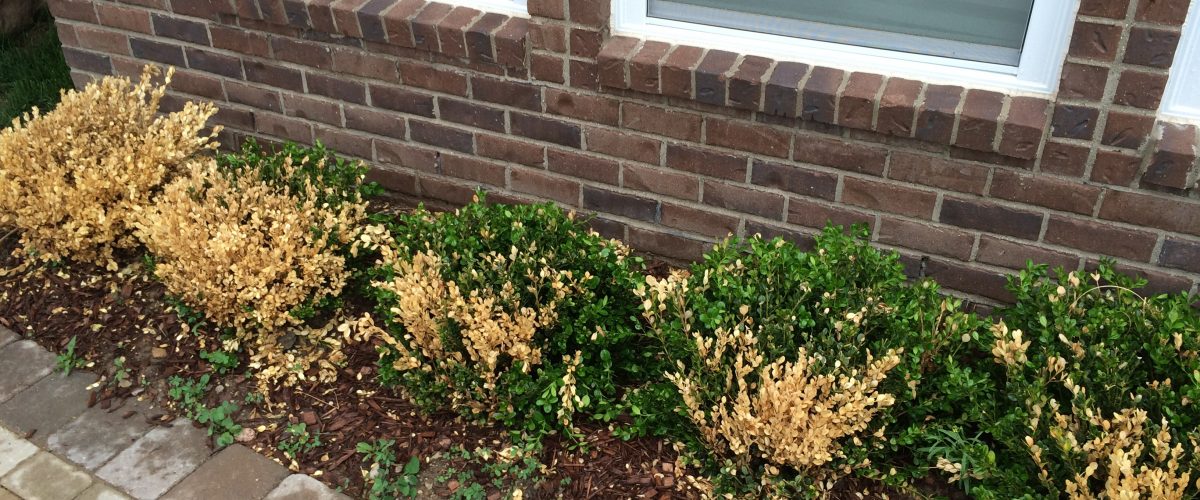


Evergreens beautifully bring life during the cold, snowy winter months. But, since they don’t require a lot of attention, it’s easy to forget that they might need extra protection to stay vibrant this time of year. While they can endure a midwest winter, a little care in the fall will decrease the potential for damage, allowing them to maintain good health through the season.
Winter burn is the biggest threat to evergreens during the cold months. While the sun is often associated as a source of “burn,” dry, freezing air can also be pretty damaging. Winter burn happens to our plants through transpiration; Evergreens extract water from the soil through their roots and store much of the moisture in their needles, releasing it through evaporation.
Conifers hold onto their needles all year long, which means they’re continually transpiring, even when they’re dormant. Not only do the harsh conditions of the cold season, like bright sun, dry air, and strong winds, increase this rate of transpiration, but the frozen ground also means there isn’t much water available to absorb. When trees lose moisture faster than they can restore it through their roots, they become dehydrated, leading to the browning effect that we call winter burn.
Luckily, winter burn is pretty easy to identify and avoid. Look for discoloration in an evergreen’s foliage. For example, bright green leaves or needles turn to a shade of yellow, rust, or brown. It starts at the tip of the needles and works its way inward towards the base. If the tree is exposed to the sun and wind and you see the damage there, it’s likely winter burn.
Understanding the local climate and how extreme temperatures and winds can affect the landscape to protect evergreens in the winter is essential. Preparation starts by avoiding pruning or fertilizing your evergreens in late summer or early fall. Pruning or fertilizing stimulates new growth, and new branch tips will not be ready for the cold months.
Come fall, give plants a deep watering just before the ground freezes and add mulch. This process locks in moisture and allows your evergreens to hydrate. A good layer of mulch delays the ground freeze and helps regulate soil temperature during the snowy season.
Next, you can consider wrapping your more fragile evergreens in burlap—this is an excellent process for newly planted trees or shrubs. Burlap helps protect young plants from winter burn, strong winds, road salts, and pesky animals.
Finally, using an anti-desiccant spray (also known as anti-transpirants) can help retain moisture in a plant’s leaves for up to six months during winter. Spraying a coating covering the needles affects the tree’s transpiration rates. Hinsdale Nurseries highly recommends a product called Wilt Pruf. Unlike other products that use chemical polymers, Wilt Pruf is an all-natural spray made from pine oil. It’s non-hazardous and biodegradable, so you can be confident that it won’t affect the growth or health of your plant.
Sometimes, winter burn is inevitable, and plants need a little extra TLC to recover, no matter the preparation. Check to see if the affected branches are still alive by scraping away a small patch of bark—if the plant tissue underneath is green, that means it’s still supporting growth. Brush off the discolored needles and give your plant a healthy drink of water in the spring, and it’ll likely bounce right back. However, the bad news, if the branch is dry and lacks color after peeling some bark back, then it’s too late, and you’ll have to prune that branch off.
Plants grown and produced locally are more well-adapted to seasonal weather conditions. When possible, purchase plants from local places like Hinsdale Nurseries.
It’s not too early to start planning for spring. Make an appointment now for a consultation with our design and installation staff to be first on the list when the crews start.
Connect with Us!
630-323-1411
7200 S. Madison St.
Willowbrook, IL
Blog: https://hinsdalenurseries.com/blog
Facebook: https://www.facebook.com/HinsdaleNursery
Pinterest: https://www.pinterest.com/hinsdalenursery/
Twitter: www.twitter.com/HinsdaleNursery
Instagram: www.instagram.com/Hinsdale_Nurseries/
YouTube: https://www.youtube.com/channel/UC5GUOu9abCvL9ZDNJBSunrA
Website: https://hinsdalenurseries.com/


